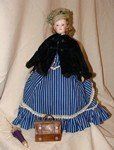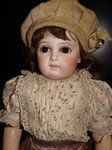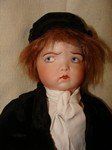Parallel to the production of porcelain dolls is developing new materials such as celluloid. Invented by the Hyatt brothers in 1887, it is considered the first plastic. It is found in the manufacture of unbreakable dolls including Rhenish Gummi and Celluloid Fabrik Co Schildkröt from 1896. One of the first French manufacturer to produce this material in the form of bather is the SIC company in 1902 which will be taken over by SNF in 1927. There is also the company Anel et Fraisse (1893-1928), which will be taken over by Convert in 1929, but also Petitcollin, which has existed since 1860. Celluloid is a very popular material in the 1930s with the arrival of hygiene. especially in the childish environment. This washable material had a lasting success until the 1950s when it was banned because of its flammability. He paved the way for all other plastics still used today such as rhodoïd, polyètilène or vinyl.
Little story of the doll
We have known the doll since always. Simple piece of cloth, carved wood archaeologists have found their trace in many civilizations. If for us the doll is a toy, she had other functions as diverse as ex-voto or ambassador of fashion.
In the eighteenth century, the pandora luxury object is mainly reserved for the aristocracy, his heirs fashion dolls will see their sustainable development thanks to the bourgeoisie in the early nineteenth century. These first dolls are craft works, commonly called "Pauline", wooden heads or molded cardboard (most often) are purchased in Germany in the Sonneberg region. They are assembled and dressed in France most often in the district of the halls where doll crafts took root. This explains the great disparity of body that can often be found right in skin but also in canvas.
In the eighteenth century, the pandora luxury object is mainly reserved for the aristocracy, his heirs fashion dolls will see their sustainable development thanks to the bourgeoisie in the early nineteenth century. These first dolls are craft works, commonly called "Pauline", wooden heads or molded cardboard (most often) are purchased in Germany in the Sonneberg region. They are assembled and dressed in France most often in the district of the halls where doll crafts took root. This explains the great disparity of body that can often be found right in skin but also in canvas.
The beginnings of porcelain
The techniques evolve and we see the appearance of glazed porcelain heads. Always imported from Germany where manufacturers produce them in large quantities and export all over the world. The first porcelain manufacture patent was found in France in 1843 by the porcelain maker Jacob Petit (1796-1868). This is the development of the toy industry. Glazed porcelain, we will go to the biscuit squeezed first and then poured. 1870 is the golden age of fashion dolls that will be manufactured until the end of the 19th century. The most famous French manufacturers are Barrois (1858-1894), François Gaultier (1860-1899), Léon Casimir Bru (1862-1899) and Jumeau
Fashion dolls
The fashion doll also called "Parisian" is criticized. It is an adult whose value is matched with the number of accessories that make up his wardrobe. Certainly she contributes to the education of the girls, especially by sewing her vast trousseau but it is considered futile, it is thought that she does not prepare the little girls for their role as mothers.
It is in this context that the baby will be born. Directly inspired by the Japanese dolls exhibited in 1851 at Crystal Place in London, the idea will soon be adopted with an almost identical copy by the German company Motschmann around 1860, Steiner in France will also produce a version close to the Japanese model but the more beautiful successes, we owe them to Jumeau in 1875 or Bru in the same years.
It is in this context that the baby will be born. Directly inspired by the Japanese dolls exhibited in 1851 at Crystal Place in London, the idea will soon be adopted with an almost identical copy by the German company Motschmann around 1860, Steiner in France will also produce a version close to the Japanese model but the more beautiful successes, we owe them to Jumeau in 1875 or Bru in the same years.
The restorer of doll
The doll of the nineteenth is fragile but it is also a toy. The repairmen are born at the same time. When a head is broken, it is simply replaced, maybe the little girl was punished ... It is known only through some novels. Have you ever read "The misfortunes of Sophie", this childish novel written in 1864 by the Countess of Ségur (1799-1874) tells, among other things, the ordeal of a poor wax doll who after losing her eyes, melted at sun, finishes his days in a box at the bottom of the garden after a funeral in order. This novel would be freely inspired by the own childhood memories of the countess herself then the myth of the wise child ...
Babies
At the end of the 19th century, when the baby was born, doll bodies evolved. They go from leather to wood and then to composition. The doll changes. The first functions appear in particular with Jules Nicolas Steiner (manufacture from 1855 to 1902), the doll sings, drinks a bottle, walk, etc ... But it remains especially in France a luxury toy that is under the full force of the German competition. These have already entered the industrial air, they have a production perhaps less refined than the French but more rational and organized. They practice a large scale of prices, they produce models of luxury as in France but also of the average range and the low end. We can mention some famous brands like Kestner who made dolls of very good qualities from 1805, Simon and Halbig (1869 to the 30s) which also produced for the SFBJ and many other manufacturers, Armand Marseille (1885- 1938) ... ..
From Twin to SFBJ
From Twin to SFBJ
from Twin to SFBJ
The company Jumeau had understood the strength of this organization and had already centralized all of its production in a single factory in Montreuil sous bois, but to face the competition, it was necessary to associate, thus was born the SFBJ in 1899 result of the alliance between the two main shareholders Jumeau and the importer Fleischmann and Bloedel joined by Gaultier and Bru. It's the end of luxury. We will diversify the quality, with the same mold, we can find several versions in biscuit with pretty clothes or cardboard molded with a paper dress. The most emblematic model of the SFBJ is the 301. This mold served all. It is found in all the qualities of the distinguished girl to the vulgar bazaar doll. It was also made to do: it is often found matching speaker or walker system, it even sends kisses ... This mold was produced from 1915 until the end of the SFBJ in 1957, it is a beautiful longevity. We find as much application for the mold 60.
From 1910, the SFBJ also produces babies of character, very expressive dolls that are found with bodies of different ages from the baby to the little child. Porcelain from one model to another can be of very different quality. There are also full heads with painted or flocked hair.
From 1910, the SFBJ also produces babies of character, very expressive dolls that are found with bodies of different ages from the baby to the little child. Porcelain from one model to another can be of very different quality. There are also full heads with painted or flocked hair.
New materials
Today
But what about the current doll? We always play the doll? Feminism has been there. The role of the woman is no longer reduced to the procreation and education of children, the little girl lives in a less cloisonné and can be interested in other games. Barbies are still very popular as heirs to fashion dolls. The circle is complete. For current adults, the game remains but the support changes. Part of SIM'S, does not it play the doll virtually? But if you want to find the charm of old dolls, maybe it's time to start a collection.

















